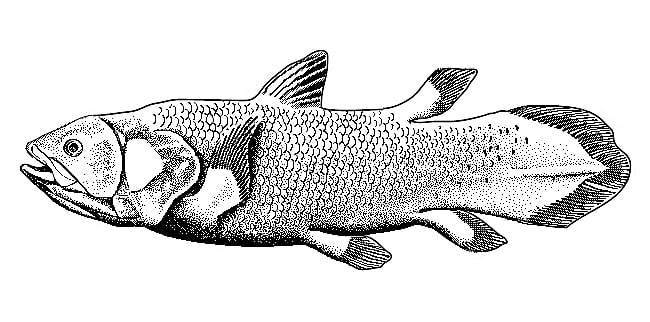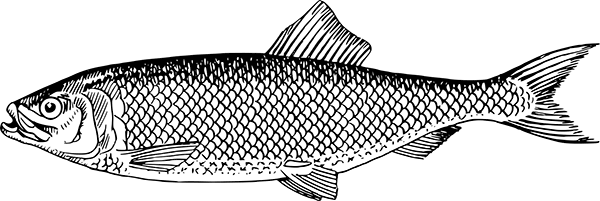On the biological classification of the herring and the taxonomic can of worms it opens up at species level and below
TAXONOMY
In Ancient Greek, Nomos means law or, perhaps significantly, custom; Taxis arrangement or order. Taxonomy is a method of arrangement. Now used for the classification of just about everything, it was coined for natural history: a way of precisely stating where each life form sits in the grand scheme of things. The word emerged in the early C19th, but systematic naming and grouping of organisms began with Carl Linnaeus’ Systema Naturae (1758). From the earliest days of their classification herrings have been uncooperative.

Of Empires, Kingdoms and Phyla
Life on this planet divides into three Empires (aka Domains, Realms or Superkingdoms). Plus the Viruses, but they’re intracellular parasites: they squat in the cells of others. Property-owning cellular life on this planet divides into three empires.
The first is the Prokaryota, which included the Kingdoms of Bacteria and Archaea. Once upon a time, archaea were thought to be bacteria, but they weren’t. Many live in impressively extreme environments and, these days, the separate kingdom they were given is recognised as another empire. The third, the Eukaryota, includes the kingdoms of Plantae, Fungi and Animalia.
In taxonomic pursuit of fish, dukedoms or a counties might have been nice, but in 1866 Ernst Haeckel, zoologist, eugenicist and promoter of scientific racism gave us the Phylum, metaphorically derived from the Greek, phylon, race or stock. There are approximately 35 phyla. We can’t be precise because taxonomists change their minds.
The phylum we’re interested in is the Chordata. At some stage in their lives, all chordates have a cartilage notochord, which, in vertebrates, develops into the spinal chord. They have pharyngeal slits (which in fish become gills), a tail behind the anus and a groove in the pharynx (which in some fish helps with filter feeding).
Of Clades, Classes and Orders
Amongst the chordates, there is the Clade or natural group Euteleostomi (bony vertebrates). Clades can be recognised at any old level below kingdom. There aren’t really enough levels in taxonomy to cover the complexity of life and/or evolution, so while each level can be a clade, they’re also there for all those in-between moments. Within systematic approaches to taxonomy, Cladistics has, by and large, won out over both Phenistics and evolutionary Darwinian Classification. All of that only happened in the second half of the C20th, however, so there’s a lot of overlap in the terminology.
The euteleostomi are also referred to as Osteichtyes (bony fish), but pickier taxonomists pointed out that it had to include the Tetrapods. 400 million years ago, the Tetrapoda emerged from the clade within the Class (or clade) of euteleostomi, the Sarcopterygii (lobe-finned fish). They also emerged from the waters. From the lobes came the limbs (tetrapod means four-footed, but is used to mean four-limbed – with an exception granted to the snakes). Some went back into the water, some started to fly, but all of them ceased to be fish. Forget about them.
Twenty million years earlier, the euteleostomihad already produced another class,the ray-finned fish, the Actinopterygii (from the Latin, actino or ‘having rays’). Eschewing lobes, for fins they developed skin membranes supported by spines.

Out of the actinopterygii came the Neopterygii who were better movers and out of them the Teleostei who, all the better to seize their prey, had more effective jaws. Ironically, hundreds of millions of years later, the teleosts found themselves supplying the overwhelming proportion of species seized with ever-greater effectiveness by the tetrapodic Homo sapiens.
Teleosts begat Otocephala {swim bladders linked to the inner ear) and theybegat the Order of Clupeiformes. The clupeiform swim bladder is connected by pneumatic duct to the gut. This enables replenishment with air via the mouth and expulsion of air via the anus. It is this which enables the herring’s communication system*.
Suborder and Family
Among the clupeiformesthere are two Suborders and seven Families.
The Denticipitoidi are a suborder with only one family, the Denticipitidae (denticle herrings) which has only one Child or Species. It lives in the rivers of Benin, Nigeria and Cameroon and is called the denticle herring. The six remaining families belong to the suborder Clupeoidei.
The Engraulidae (anchovies) has 140 species, but we tend only to eat nine of them. Possibly the key taxonomic fact about Spratelloididae is that among its species the sprat is not included. Pristigasteridae are longfin herrings, a kind of sardine once numbered among the Clupeidae, but now not. The Chirocentridae are wolf herrings, of which there are two species, the whitefin and the dorab. Round herrings belong to the Dussumieriidae.
Sixth of the Clupeoidei (seventh of the clupeiformes) is the Clupeidae family: the herrings and sprats; those sardines or pilchards which aren’t round or longfin herrings; the shads and the hilsa. And the menhaden. All of the former Clupeidae inspire culinary devotion, but the menhaden doesn’t. It is a fish so oily its name derives from the Algonquin for fertilizer.
Of Genus and Species
‘Clupeiform’ derives from Clupea, which is Latin for sardine. Taxonomically, however, sardines can variously be Sardina, Sardinella, Sardinops, Dussumieria and Escualosa, but, although clupeiform, they’re never Clupea.
Whilst zooarchaeology has recently established that, in the land of the Belgae at least, Romans used herrings (and sprats) to make fish sauce, in De Harengo (1643) Paul Neucrantz exhaustively established that herrings, although clearly similar to sardines, were never recognised by classical authority. Carl Linnaeus, however, was Swedish and possibly, therefore, more focused on herrings than sardines. Either way, in 1758 he allocated Clupea as the herring’s Genus. The Species Atlantic herring, King of Fishes and hero of this encyclopaedia, he called Clupea harengus.
That’s where the trouble really starts.
Of Species and below
Notwithstanding their many differences, taxonomists allocate all commercially-fished herrings of the North Atlantic, North Sea, Western and Central Baltic to the species Clupea harengus. Linnaeus will also have eaten the small Baltic herring, which adapted to the brackish waters of the eastern Baltic and the Gulf of Bothnia. He recognised it as Clupea harengus membras.
In taxonomy, genus and species combine binomially (Clupea harengus). The trinomial (Clupea harengus membras) indicates Subspecies or Variant.
It is in the herring’s nature to adapt, physiologically, to the temperature and salinity of spawning and very early feeding grounds. Offshore herrings tend to be larger, inshore ones smaller. Think of Craster as opposed to Manx or Loch Fyne kippers.
In his metaphorically dodgy, but zoologically remarkable Naturgeschichte des Herings (1898), Friedrich Heincke* enumerated 65 measurable characteristics through which herrings could be racially identified. Working with just 26 characteristics he found 14 distinct races in the North East Atlantic, North Sea and Baltic (if we ignore the sprats, amongst which he identified a further five).

In 1931 Werner Schnakenbeck gave them trinomial subspecies status, but English fish scientist William Hodgson was already baulking at the baggage of racial theory. It wasn’t a rejection of what Heincke had identified, but uneasiness in the context of what was happening in Europe. In Clupeidae (1952) the great Russian systematist AN Svetovidov* similarly preferred population to race.
What is species adaptation, however, and what is species? When is a subspecies merely a population? When does it become a species?
At some point of pre-historical Arctic warming* the Atlantic herring made its way over the top of the Russo-Siberian landmass and became the Pacific herring (Clupea pallasii). A different species. Based on the Atlantic herring’s high vertebral count against a lower count for the Pacific herring, LA Ponomareva proposed species level distinction. Svetovidov railed against her limited authority and insufficient acquaintance with the literature. For him it was the trinomial C harengus pallasii, but Ponomareva won out.
Darwin saw all subspecies as being on a journey to species status, but had the Pacific herring arrived? With the herring, vertebral counts are averages. The variation in averages between C harengus populations and between them and C pallasii is comparable. Variation exists within and between any group you care to choose. The number seems to respond to both genetic and environmental factors, the latter varying both from year to year and ground to ground. In a Japanese study* there was even variation between vertebral averages in hatchery- and wild-reared samples from the same population.
Complicating the picture, in the early Holocene (ten or eleven thousand years ago) some Pacific herrings swam back towards the West and became the Checha-Pechora herring (C pallasii suworowi) and the White Sea herring (C pallasii marisalbi). Subspecies.
The White, Pechora and Kara Seas are within eastern range of the Atlantic herring and mitochondrial analysis* of White Sea herrings reveals evidence of miscegenation in 7%. Some White Sea herrings swam even further west to Norway’s Balsfjord, where the figure rises to 21%.
And a study of biological data from 428,773 Norwegian, North Sea and Western Baltic herrings collected between 1970 and 2015* suggests that atypical vertebral counts might also result from interbreeding.
Such anomalies spread out across plantae and animalia kingdoms. And even though it’s less invested in subspecies, fungus taxonomy seems to have become more problematic still. There is general acknowledgment of species (subject, of course, to revised classification) as a fundamental unit. Below that it’s anybody’s game.
Of Demes, Metapopulations, ESUs and more
The whole structure of traditional biological taxonomy codifies a way of looking at the world, shaping and in turn shaped by Darwinian thinking. And its baggage. The new possibilities in genetics increasingly deliver more data than its namings can accommodate.
In a 1998 paper on fish studies definitions*, there’s an entry for Deme which refers you to Local Population:
The term deme was first suggested by Gilmour and Gregor (1939) as a synonym for population, but as population gave way to local population, Wright (1955) and others suggested deme as the synonym for local population.
Metapopulation is defined as an aggregation of patchily distributed local populations that are interconnected by migration between the local populations.
Under Species, it says of Darwinian thinking:
This typological or morphological concept of a species may have reached its peak when some taxonomists even tried to decipher species based on percentages of shared and unique morphological characteristics (Ginsburg 1938). The morphological species concept began to fall apart when systematists realized that it did not work well for some species that demonstrated considerable polymorphic diversity or when two species shared extremely similar morphologies.
Species like those of the herring…
The paper notes, Reduced attention to subspecies is underway due to modern genetic techniques. The authors’ preference is for the Evolutionary Significant Unit (ESU), but the proliferation of synonyms continues apace.
As well as the ESU, a 2006 study of taxonomic considerations for subspecies* notes the Biological Species Concept (BSC), the Phylogenetic Species Concept (PSC) and the Distinct Population Segment (DPS).
In a contested space that includes species and everything below, all of these and probably more have their advocates. As legally binding acts and agreements shape action on conservation (and the related territory of fish stock management) language is important, but problematic.
It may be too late for herrings to mount any retrospective taxonomic challenge, but the authors attempt to address the issue going forward:
We propose that, as a starting point for discussion about subspecies criteria, minimal biological requirements in most situations include two criteria based on discreteness of the population in relation to the remainder of the species to which it belongs and the biological significance of the population to the species. This is in contrast to “evolutionary significance,” which implies more species-like relationships. In other words, if a taxonomic subspecies does not satisfy these criteria, then the biological legitimacy of the particular subspecies classification should be questioned. Modification of the discreteness criterion would be necessary to allow for cases where subspecies contact one another along a stable hybrid zone but maintain their taxonomic integrity elsewhere. Adopting these criteria would provide for consideration of multiple types of biological data, not just molecular genetic data, yet would still carry the requirement of defining differences. Satisfaction of these criteria, however, would not necessarily warrant subspecies recognition via a Linnaean trinomial.
In this divided world, ray-finned fish or bipedal tetrapod, whoever we are, whoever we choose to be with, however we are identified or choose to identify, maybe we should all just try to be the best version of ourselves…
Acknowledgments & Corrections
I’d like to thank my good friend Guy Cook for insistence on the necessity for an entry on Taxonomy. At the time, I was lost in the need to rewrite various historical entries in the light of recent herring zooarchaeology, but he was right.
Meanwhile, if you’re a taxonomist and would like to correct or update any of this entry, please don’t hesitate to contact the herripedia.
